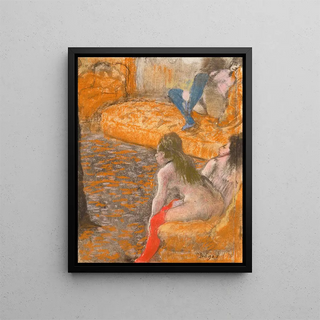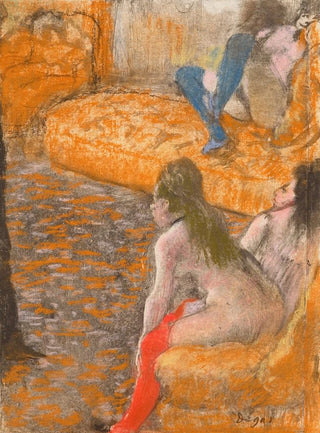Art print | Waiting for a client - Edgar Degas


View from behind

Frame (optional)
Art print Waiting for a client - Edgar Degas – Captivating introduction
In the fascinating universe of art, some works manage to capture the very essence of everyday life with such intensity that they become timeless witnesses to our humanity. "Waiting for a client" by Edgar Degas is a perfect example. This painting, which evokes the hushed atmosphere of a Parisian hair salon, immerses us in a suspended moment where waiting becomes an art form in itself. The scene, imbued with melancholy and intimacy, draws the eye and invites contemplation. Every detail, every gesture, seems to tell a story — that of the characters inhabiting this space, but also that of an era where modernity and tradition coexisted.
Style and uniqueness of the artwork
Degas, master of Impressionism, stands out for his ability to capture movement and emotion. In "Waiting for a client," he deploys a subtle palette of colors and lights that give the scene a lively yet delicate atmosphere. The characters, frozen in silent anticipation, are rendered with such precision that they almost feel tangible. The viewer's gaze is naturally drawn to the woman at the center of the composition, whose expression reveals deep melancholy. Degas's traits, both realistic and Impressionist, create a harmonious balance between faithful representation and personal interpretation. Every brushstroke is an invitation to explore the nuances of the human soul, to feel the emotion emanating from this scene.
The artist and his influence
Edgar Degas, although often associated with the Impressionist movement, forged a style that is uniquely his own. Born in 1834 in Paris, he was influenced by his travels in Italy and by Renaissance masters, but it was in depicting modern life that he truly found his voice. His works, whether of ballerinas, café scenes, or portraits, reveal a unique sensitivity to the human condition. Degas was also a pioneer in using new techniques, notably asymmetrical composition and dynamic framing, which paved the way for

Matte finish

View from behind

Frame (optional)
Art print Waiting for a client - Edgar Degas – Captivating introduction
In the fascinating universe of art, some works manage to capture the very essence of everyday life with such intensity that they become timeless witnesses to our humanity. "Waiting for a client" by Edgar Degas is a perfect example. This painting, which evokes the hushed atmosphere of a Parisian hair salon, immerses us in a suspended moment where waiting becomes an art form in itself. The scene, imbued with melancholy and intimacy, draws the eye and invites contemplation. Every detail, every gesture, seems to tell a story — that of the characters inhabiting this space, but also that of an era where modernity and tradition coexisted.
Style and uniqueness of the artwork
Degas, master of Impressionism, stands out for his ability to capture movement and emotion. In "Waiting for a client," he deploys a subtle palette of colors and lights that give the scene a lively yet delicate atmosphere. The characters, frozen in silent anticipation, are rendered with such precision that they almost feel tangible. The viewer's gaze is naturally drawn to the woman at the center of the composition, whose expression reveals deep melancholy. Degas's traits, both realistic and Impressionist, create a harmonious balance between faithful representation and personal interpretation. Every brushstroke is an invitation to explore the nuances of the human soul, to feel the emotion emanating from this scene.
The artist and his influence
Edgar Degas, although often associated with the Impressionist movement, forged a style that is uniquely his own. Born in 1834 in Paris, he was influenced by his travels in Italy and by Renaissance masters, but it was in depicting modern life that he truly found his voice. His works, whether of ballerinas, café scenes, or portraits, reveal a unique sensitivity to the human condition. Degas was also a pioneer in using new techniques, notably asymmetrical composition and dynamic framing, which paved the way for






